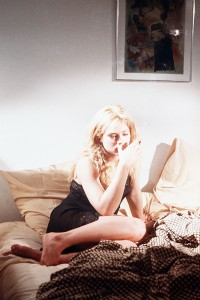Sex, lies and obsession play out in the somber streets of a rainy Vienna in director Nicolas Roeg’s 1980 baroque masterpiece “Bad Timing.”
From its opening scene, in which paintings by Austrian artist Gustav Klimt appear alongside the jazz-tinged music of singer Tom Waits, “Bad Timing” comes on like a fever dream of Freudian psychoanalysis and a popular detective novel. The film, aptly advertised upon its initial release as “a terrifying love story,” will be screening at The Cinefamily this Friday.
Art Garfunkel stars as Alex Linden, a young expatriate living in Vienna as a professor of psychology. Educated and reserved, he has the look of a young Ivy League graduate. While at a party one evening, Alex meets his opposite: the alluring Milena (Theresa Russell), an enigmatic beauty and pill addict.
The two begin a mutually destructive love affair and embrace a decadent and hedonistic lifestyle. However, after Milena is rushed to the emergency room following a supposed suicide attempt, Inspector Netusil (Harvey Keitel) begins investigating their relationship and realizes that everything isn’t quite as it seems.
When “Bad Timing” was first screened in 1980, an executive from the film’s own distributor, shocked and appalled at what he had seen, remarked that he had just witnessed, “a sick film made by sick people for sick people.” Due to its sexual explicitness and depictions of voyeurism and rape, the Motion Picture Association of America initially slapped it with an X-rating, and it seemed to flitter away from public consciousness without causing any sort of stir.
In hindsight, however, “Bad Timing” is much more than the minor piece of exploitation cinema it was initially criticized for being. It is a provocative and atmospheric film made by a criminally underrated director at the top of his game.
If one wants to see a movie that so perfectly uses music, “Bad Timing” should be an obvious choice. The sheer variety of musicians and musical styles in the film is impossible to go unnoticed. Eclectic and expansive, the soundtrack is full of artists with completely divergent styles, such as Billie Holiday and The Who, and yet all fit together perfectly.

In perhaps its most musically effective sequence, Keith Jarrett’s classic jazz piano album “The Köln Concert” plays while Alex and Milena’s thoughts are heard – before they actually begin speaking to each another. It’s a jarring and dynamic sequence that demonstrates the level of experimentation for which Roeg has become known.
However, experimentation in “Bad Timing” does not end there. Like many of Roeg’s works, the film has a nonlinear structure. By having the film play out nonsequentially, the film has a disjointed quality that adds to its labyrinth-like mystery.
The result is dizzying and makes “Bad Timing” all the more puzzling and fragmented – the individual pieces seem jumbled and don’t quite coalesce until the film’s end. It’s one of the few movies that uses jumps in time frames to advance the story and add to its suspense rather than make the film come off as gimmicky and pretentious.
“Bad Timing” is a forgotten little gem – an ethereal, cryptic jaunt into a dark underworld. More than three decades later, Roeg’s psychosexual masterpiece is still as polarizing, disturbing and mysterious as it was on initial release.
